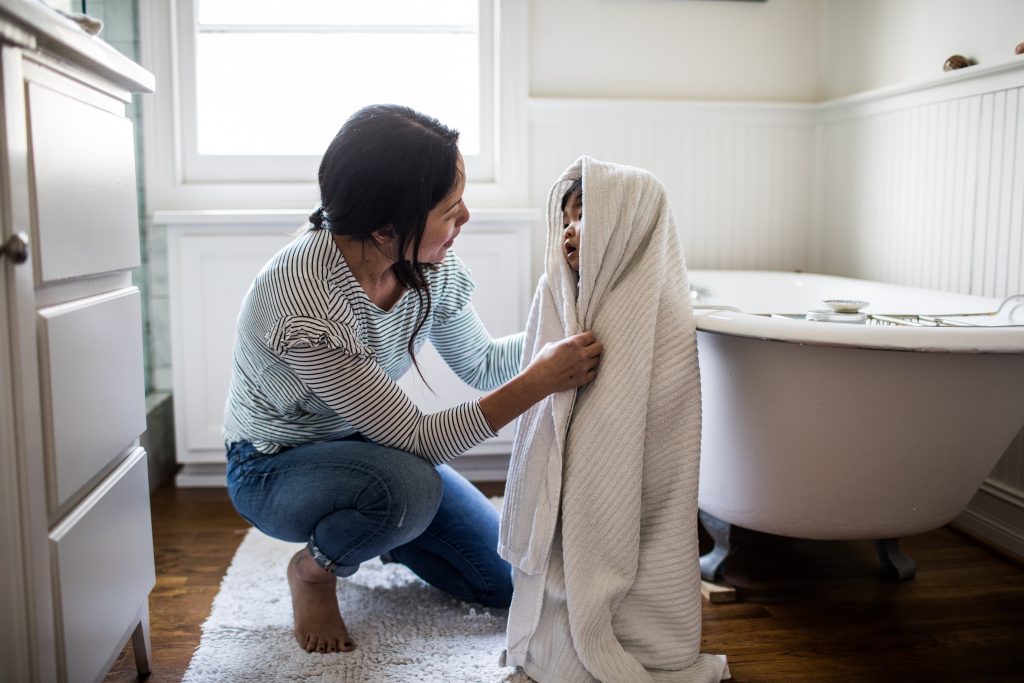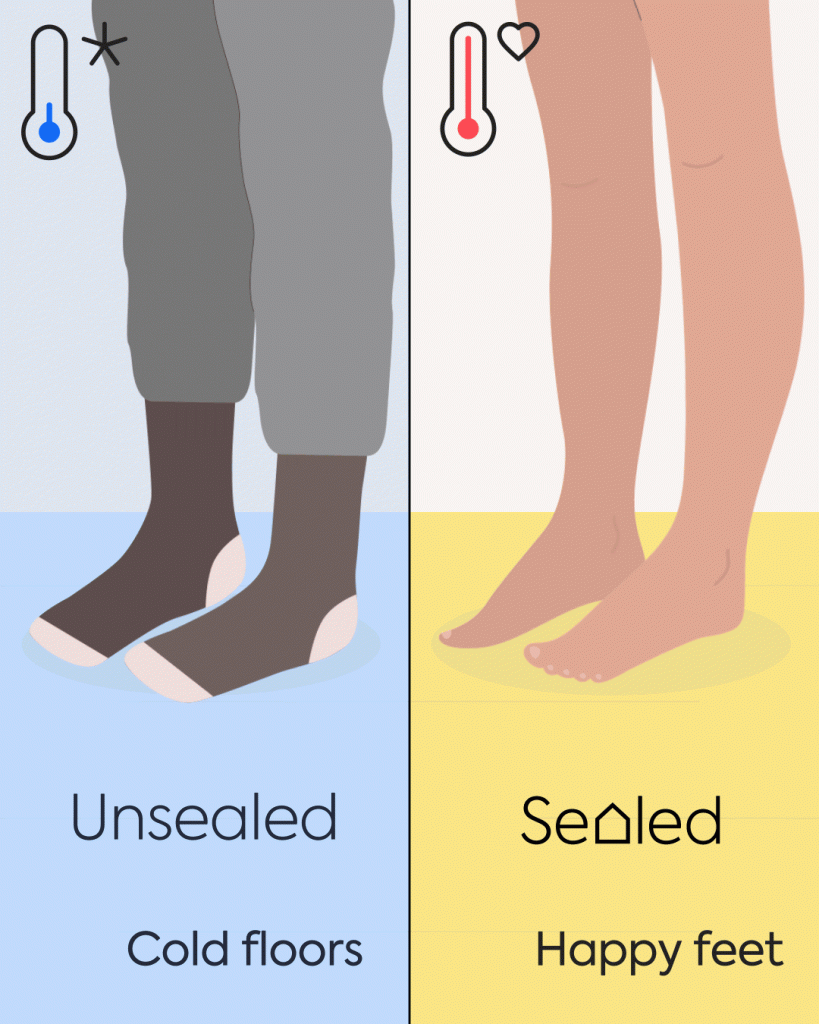If you’ve got freezing cold floors, that’s a problem—one that can be fixed. We’ll help you troubleshoot in this guide.
Winter can be brutal, especially with things like polar vortexes, deep freezes, and snow in Texas—all due to big weather pattern changes.
And since homeowners usually have to deal with annoying (and potentially dangerous) issues like ice dams taking the front seat of home maintenance, comfort can sometimes take a back seat.
But it’s hard to ignore how uncomfortable you are in your house when the year’s coldest months bring you the dreaded ice-cold floor.
Cold air coming from your floor can be jarring, but you’re in luck: This troubleshooting guide reveals some of the most common causes of cold floors and the best solutions to solve them.
And, depending on where you live, you can get those fixes with an energy-savings guarantee. Find out how.
In this article, we’ll cover both quick fixes and more long-term solutions. You’ll cover:
- Why do floors get so cold?
- How to troubleshoot your cold floor problem
- How insulation and air sealing work together to warm up floors permanently
- Common questions about cold floor issues
Why do floors get so cold?
No one wants it to feel like winter inside their home. When your house just can’t get warm, it leads to discomfort, arguments over the thermostat, and energy waste due to overworked HVAC systems.
Cold homes (and consequently, cold floors), have also been linked to increased health issues during the winter.
So how do floors get so cold in the first place? Well, it all points back to how air moves into and out of your home.
Let’s start by understanding the stack effect, or how outdoor air moves into and throughout buildings. The stack effect is what causes your floors to be so cold in the winter.
I didn’t think Sealed could make my drafty, cold house warm.… But I’m not using heat [because now my house] just contains it.… If you have a cold home, do it!! It’s worth every penny.
Joshua L., Sealed customer
Here’s how the stack effect works
Heated, warm air inside your home is less dense than cold air outside. Since warm air is lighter, it naturally rises up and out through the top of your house.
As hot air rises out of the top of your attic, it creates a vacuum that sucks back in cold air from outdoors into your house via seams, cracks, and crevices (called air leaks).
And all that cold air you feel under your feet? It is actually being drawn in through open, unsealed gaps and seams in your house’s foundation and floor joists.
Homes with uninsulated and unsealed basements or crawl spaces are especially susceptible to heat loss. In fact, floors on the first floor of a home tend to be the coldest because they are directly above the basement or crawl space.
Even if you don’t have a basement or crawl space, an unsealed foundation can cause the same phenomenon.
Plus, the stack effect keeps cold air lower in your home, all while your paid-for heat in the winter rises toward the ceiling, moves on upstairs, and heads straight out of the attic if you don’t have sufficient insulation in place.
90% of US homes are under insulated.
NAIMA.org
For a quick visual of how the stack effect works to create cold spots (like cold floors) and drafts in your home, check out the video below.
Also, the type of flooring in your home can add to that cool-floor feel. Tile floors are known to hold the most cold, followed by hardwood floors.
Of course, cool tile or hardwood floors aren’t necessarily a bad thing if it’s summer, but in the winter when you’re just trying to stay warm, cold floors obviously aren’t ideal.
But that doesn’t mean you have to cover your beautiful, high quality hardwood floors in wall-to-wall carpet to stay warm.
Air sealing, crawl space insulation, basement insulation, and attic insulation all work together to stop cold floors for good.
(Bonus: Insulation and air sealing upgrades keep your home cooler in summer, too. These improvements cut energy waste year round.)
Quick fixes for your cold floor problem
Your bare feet deserve a comfortable place to land and cold floors in the dead of winter just won’t do.
But not all is lost.
Let’s start with some quick fixes so you can get warmer floors fast.
Your house shouldn’t feel like an igloo. To find out what igloo science and your house have in common, read How are igloos warm inside?
Space heaters
Space heaters can be a short-term fix for your house’s cold spots—but they’re just that, a very short-term quick fix. They’re not very energy efficient, but they do help make you more comfortable when you have a cold draft coming in along your floor.
Of course, it’s never good to leave space heaters unattended, so this quick warmer is a temporary fix—but it can be a nice reprieve while you work on more permanent solutions.
Pro tip: Once your room is warm, unplug your heater. A space heater left on for just 8 hours a day can hike up your electric bill by a whopping $42.30 per month (1)! (And that was before electricity prices went up!)
Fires caused by space heaters are responsible for 88% of fire deaths in US homes.
NFPA
Area rugs
Area rugs are not only a less-expensive alternative to installing carpet, but they also provide a quick and non-permanent solution. Large area rugs immediately address your cold feet and act as extra insulation for cold floors.
Of course, area rugs don’t solve your home’s overall insulation or air sealing problems, but they can be a nice reprieve from icy mornings in the wintertime and add personality to your home decor.
Thermal curtains
Believe it or not, windows are prime real estate for many of your house’s air leaks.
Thermal curtains can help with uneven temperatures and drafts near your windows and keep your room a bit warmer, possibly alleviating some of that chilly feeling along your floors.
But thermal curtains aren’t a cure-all. They’re a temporary solution to a larger issue: the air leaks around your drafty windows that are pulling in all that cold air.
To fully air seal a house from top to bottom takes professional help, but you can start by weatherstripping and caulking the air leaks around your windows yourself.
Slippers and socks
We would be remiss if we didn’t address one of the easiest, quickest short-term fixes out there: warm, thick winter socks and a pair of good house shoes.
This could be the easiest, quickest fix, but it’s not for everyone—and it doesn’t solve your house’s cold floor problem.
At Sealed, we’re firm believers that you shouldn’t have to fight over the thermostat or wear two pairs of socks just to be comfortable in your own home.
So let’s dig into some long-term cold floor fixes.
Permanent solutions for cold floors
There are a few things you can do to warm up your floors, but feel free to tap here to skip ahead to the solution that fixes the underlying problem.
Change your flooring materials
The type of flooring in your home can play a significant role in floor temperatures.
Vinyl plank flooring with the right underlayment can be great for added warmth.
Or you might opt for carpet flooring across most of your house, or at least in the bedrooms, and carpet works as a decent insulator.
Changing your flooring can be an excellent way to update your home and add an extra layer of warmer underlayment, but it doesn’t stop the stack effect from pulling cold air into your home.
(Remember when we discussed the stack effect earlier in this article? Tap here to get a refresher of how the stack effect makes your floors cold.)

Radiant heating
Radiant floor heating is another long-term option, and it will definitely make your cold floors warmer. It warms your room (and the floors) by directly heating the floor.
But installing radiant floor heating is a pretty intrusive process that requires a professional—it’s certainly not a DIY fix for the vast majority of homeowners.
Plus, it’s a much pricier option than, say, buying a new rug, as this type of heating system costs around $6 to $20 per square foot to install.
Because of its intrusive installation and higher cost, many homeowners use it as a supplemental heating feature in tiled bathrooms or sunrooms.
Cold air can still travel into a home even with radiant floor heating, and even if you no longer feel like your floors are icy cold.
Keeping your floors warm in winter is more than a floor problem. It’s a whole-home airflow problem.
The best way to fix a cold floor is to insulate and air seal your house in the right places to stop airflow issues.
Insulating your home
Want a permanent fix to cold floors?
It’s time to upgrade the insulation in key areas in your home, including your basement, foundation, crawl spaces, and attic.
Most often, foundation air sealing, basement rim joist insulation, and crawl space sealing and insulation are the first steps a home performance contractor will take to keep the cold air from coming in… and stop your cold floor problem for good.
(No flooring rip-up required!)
Beyond that, insulating the walls of the foundation will keep heat inside your house, making your basement or crawlspace warmer.
Different areas of your home call for different insulation materials and techniques (not every nook and cranny requires the familiar pink fiberglass insulation batts), so a home performance contractor can help you decide between cellulose insulation, spray foam insulation, foam board, or Rockwool—and where they should go in your home.
Sealed did a great job with insulating my home.… I used to have such a draft in my bathroom from my vent you could see the shower curtain move from the small breeze. Sealed has fixed that issue.
John B., Sealed customer
Air seal your home
Proper air sealing and insulation make a great team.
Air sealing improves the efficiency of your insulation and it closes up all those pesky air leaks—which can waste 25–40% of your home’s heating and cooling energy (2)!
Air leaks can be found all over your house, including:
- Around doors and windows
- In the attic
- Near rim joists
- Close to plumbing fixtures
- In your fireplace
- Around bathroom fans
…and more.
So it’s important that you find an expert contractor to get the job done right.

How sealing and insulating keep your floors warm
Cold floors can tell you a few things about your home:
- Your house is not properly sealed
- You’ve got poor insulation
- You’re wasting energy
- You’ve got a home comfort problem
Studies show that about 35% of US residential energy use is totally wasted (3).
By adding insulation to your foundation, attics, crawl spaces, and accessible basement rim joists—and by reducing unwanted air flow via professional air sealing—homeowners can reduce their energy bills by an average 15% (4).
At Sealed, we’ve done this kind of work in plenty of homes.
And we’ve seen homeowners cut their energy use up to 50% when doing whole-home energy retrofits, including high-performance insulation, air sealing, and energy-efficient heat pump HVAC.
Homeowners can reduce energy costs up to 50% with insulation, air sealing, and heat pump HVAC upgrades.
(And while you’re at it, here are a few more ways to up your home’s energy efficiency while also boosting your home value.)
When it comes to air sealing and insulation, less energy waste and total home comfort go hand in hand.
Let’s break down how it works:
- Air sealing seals your house from top to bottom, leaving no room in your crawl spaces or basements for the cold outdoor air to enter into your home during the winter. A properly sealed home also improves your air quality and lowers humidity levels. Learn more about air sealing in our complete guide.
- High-performance insulation protects your home against uneven temperatures and losing the heat that you’re paying for, even on the coldest winter day. Fully insulated homes block heat escape, causing your home to feel better in the winter.
Make your house cooler in summer, warmer in winter, and more efficient all year long with Sealed.
Complete our quick (and easy!) 2-minute questionnaire to see if you can get your cold floors fixed for good with high-performance insulation and professional air sealing—all with flexible payment options that work for you.
Now my house is not only cozy and warm this winter, but we use far less energy to keep it that way.
Robin R., Sealed customer
Frequently asked questions about cold floors
When your floors just won’t stop being cold, it makes you wonder: What in the world is going on? How do I stop it?
Check out some of the most common questions about cold floor problems below.
- Why are my floors so cold in the winter?
- How do you heat a cold kitchen floor?
- Do rugs help with cold floors?
- Will insulating my floor make it warmer?
- How do you heat a floor?
- How to go about insulating a floor?
Don’t see your question here? Don’t fret.
We’re home comfort experts, and we’ve helped thousands of homes feel better and fix uneven temperatures for good.
Call us at 917-382-3729 to get your questions answered.
Why are my floors so cold in the winter?
Cold floors are due to a phenomenon called the stack effect and are a symptom of a larger whole-house problem.
Many foundations, basements, and crawl spaces have poor insulation (or none at all) and air leaks, which directly cause unbearably cold floors in the winter.
Want to know how to keep your floor from getting cold?
The key is to keep your home well-insulated and air sealed. (And this work also stops drafts, uneven temperatures, heat escape, and energy waste.)
Give us a call to learn more about our custom comfort upgrades.
How do you heat a cold kitchen floor?
A cold kitchen floor is usually a sign of an uninsulated, unsealed crawl space or basement.
When a home is well insulated, uneven temperatures and cold floors can become a thing of the past. That means even the places that were once the coldest in the house, like the kitchen floor, feel comfortable again.
You could install radiant floor heating or put a space heater in the kitchen, but that would only increase your energy bills and wouldn’t solve the underlying problem: icy cold air coming into your house through the crawl space or basement.
Do rugs help with cold floors?
Yes, area rugs can help add a light layer of insulation to your cold floors and make them more comfortable, although they’re not a permanent fix.
Will insulating my floor make it warmer?
Insulating your floor adds comfort, but it won’t fix the underlying issue. How well your home’s foundation, attic, basement, and crawl spaces are insulated and sealed determines if cold air is kept outside and away from your floors.
Tap here to learn more about the stack effect, how it causes cold floors, and why insulating a floor is only a temporary fix.
How do you heat a floor?
You can heat a floor with a process called radiant floor heating. A radiant floor heating system immediately heats the floor, and the heat rises and spreads throughout the space.
How to go about insulating a floor?
There are several ways to insulate a floor. While carpet is a simple, less-invasive way to better insulate your floor, there are also underlayments that can add a layer of insulation between the subfloor and floor.
Over cold floors? Get the permanent fix.
At Sealed, we’re the home comfort experts. We work with homeowners to make homes healthier, feel better, and cut energy waste.
If your floors feel like ice, rooms are too hot or cold, or you’ve got annoying drafts coming in from your windows, we customize a plan to fix it—at no upfront cost! See how the payment program works.
We’ll find trusted and vetted local professionals, negotiate pricing on your behalf, manage your project, and—most of all—make sure everything goes as planned and the work is done right.
Complete our quick questionnaire to see if your house is eligible.

Get our FREE guide to a more comfortable, efficient home. (Bonus checklists and case studies included!)
Learn how 3 core efficiency upgrades can make your home more comfortable year round… and warm up your floors, too.